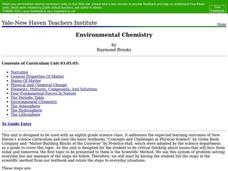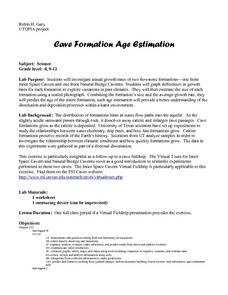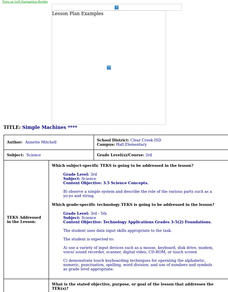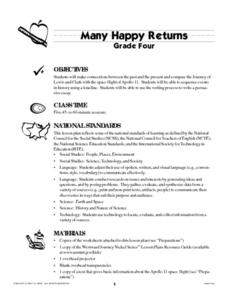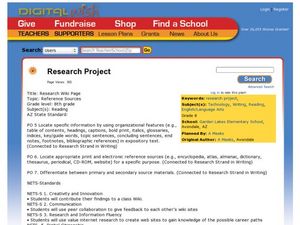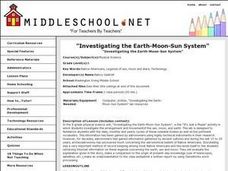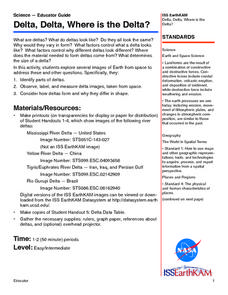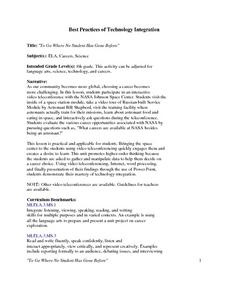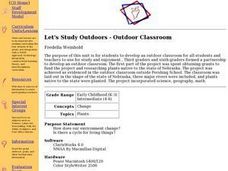Curated OER
The Difference Between Comets, Meteors And Asteroids
Students use Venn diagrams to highlight the similarities and differences between comets, meteors, and asteroids.
Curated OER
Environmental Chemistry
Eighth graders are introduced to the topic of Environmental Chemistry. In groups, they review the steps within the scientific method and develop their own hypothesis and design an experiment. They solve equations related to the...
Curated OER
INDUSTRY AND THE ENVIRONMENT
Seventh graders create a final project called Industry X (which was previously researched in the unit) has plans to build in town. There is a special town meeting scheduled to discuss this matter and allow everyone to express their...
Curated OER
Cave Formation Age Estimation
Students investigate growth rates of flowstone formations. They view a virtual field trip and discuss how flowstones form. They observe the cave fieldtrip and predict the growth rate for a cave formation. They graph growth rates and...
Curated OER
Trout across America
Students research trout and salmon and create a report. In this trout and salmon lesson plan, students research where trout live in the United States, fill out a graphic organizer, and create a report on their findings.
Curated OER
The Fault Line
Students use cardboard models of the North American and Pacific plates and sand to investigate what happens when there is an earthquake or movement along the boundaries of the plates.
Curated OER
Arctic cleanup
Ninth graders examine pollution problems and how it affects the community. In this arctic cleanup lesson students study ocean currents and how they affect pollution.
Curated OER
Simple Machines - Kid Pix
Third graders recognize simple machines in their environment. They create a picture of his/her simple machine in Kid Pix Studio. Once students have completed their picture have them save it to their desktop or disk. Next they create a...
Curated OER
Animal Research Project
Third graders prepare an oral report using Appleworks to present information on their animal. They write a short narrative comparing and contrasting their animal to another students and, after watching other presentations, discuss what...
Curated OER
Simple Machines
Learners recognize simple machines in their environment, create a picture of a simple machine using KidPix Software, and appropriately name and identify the type of simple machine that they have created using their keyboard.
Curated OER
Many Happy Returns
Students compare the journey of Lewis and Clark with the space flight of Apollo 11. Students sequence events using a timeline. Students write a persuasive essay trying to persuade the people of the US to support space exploration.
Curated OER
Phases of Matter
Eighth graders practice using correct vocabulary and apply content knowledge related to phases of matter when answering questions about situations or observations from everyday life.
Curated OER
Investigating and Using Biomass Gases
High schoolers examine the definitions of biomas gasification and generate their own biomass gas. In this renewable energy lesson plan students collect gases and roast a marshmallow.
Curated OER
Avalanche!
Students build a model representing a snow-covered mountain out of flour, sugar, and potato flakes. Then they use the model to recreate an avalanche.
Curated OER
Microscopes: Is what you see, what you got?
Eighth graders identify the parts and functions of the microscope. For this biology lesson, 8th graders observe different samples under different types of microscopes. They compare and contrast the details they see.
Curated OER
Natural Records of Change: Working with Indirect Evidence of Past Climates
Students take part in a dice game to better explain the differences between direct and indirect evidence. They apply this knowledge to how scientists have used both types of evidence to determine how climate has changed over time.
Curated OER
Classification of Animals
Sixth graders examine two-way classification systems using four mutually exclusive groups and two dimensions simultaneously. They then are given a set of plastic animals, asked to create a two-way classification system, then asked to...
Curated OER
Pond Life Identification Kit
Students explore ecology and biodiversty. They use the wet-mount procedure to make several slides to view using the microscope and draw what they see.
Curated OER
Research Project
Students learn the characteristics of arachnids by researching the arachnid of their choice and producing a 4 to 5 paragraph research paper.
Curated OER
Investigating the Earth-Moon-Sun System
Eighth graders research Native American legends involving the sun, moon, and stars and compare them to the origin of present day knowledge. They create a written report and make an oral presentation of their findings to the class.
Curated OER
Delta, Delta, Where is the Delta?
Students explore several images of Earth from space. They identify parts of deltas. They observe, label, and measure delta images, taken from space. They consider how deltas form and why they differ in shape.
Curated OER
To Go Where No Student Has Gone Before
Eighth graders participate in interactive video teleconference with employees of NASA Johnson Space Center. Students visit inside of space station module, take video tour of Russian-built Service Module by Astronaut Bill Shepherd, visit...
Curated OER
Let's Study Outdoors - Outdoor Classroom
Students research native plants. They identify the plant by scientific name, size, amount of water needed and color. Pupils measure and plot an area of school property. Students create an outdoor classroom. Additional cross curriculum...
Curated OER
Under The Sea
Second graders study how a tsunami is formed by underwater events such as earthquakes, volcanoes or landslides. They discuss what they knew about living and non-living things in the ocean.

